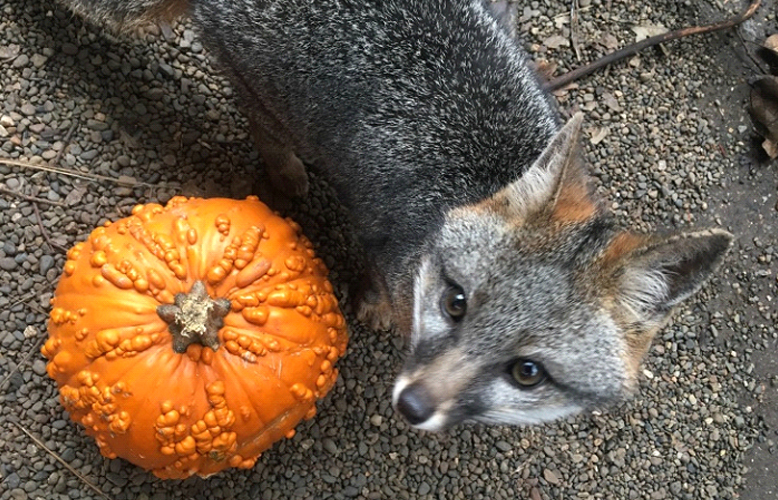(Photo of gray fox courtesy of Jen Obsburn Eliot)
Museum acquires a gray fox from Wildlife Images in Grants Pass
The High Desert Museum has a new wildlife ambassador: a juvenile gray fox from Wildlife Images Rehabilitation and Education Center in Grants Pass, Oregon. The young male fox was brought to their rehab center in September because it was ill and exhibiting some neurological deficiencies. While being nursed back to health, the fox exhibited some unusual behavior including not being fearful of humans. Wildlife Images and the Oregon Department of Fish and Wildlife determined that despite the best efforts to correct the behavior, the best option for the fox was to place him in a permanent facility as an educational ambassador.
“We are excited to add this new species to the Museum’s wildlife collection,” said the Museum’s Executive Director Dana Whitelaw, Ph.D. “Gray foxes are secretive and mostly nocturnal in nature, so this is a great opportunity to introduce a unique wildlife species to our members and guests.”
Gray foxes have silver-gray fur on the back and face; reddish fur behind the ears, chest and legs and patches of white on the throat and belly. The black-tipped tail is approximately 1/3 the fox’s body length. A member of the dog family (Canidae), gray foxes have strong, hooked claws that enable them to climb trees to hunt birds and small mammals or take shelter in tree cavities or abandoned bird nests. Though the gray fox is rarely found in the High Desert portion of Oregon, the species is widely distributed from southern Canada, across most of the US and into portions of South America.
“Our wildlife staff will work with the fox and use him to educate visitors about carnivore conservation in our region, and efforts by various nonprofits and governmental agencies to study the distribution, abundance and ecological significance of carnivores, including rare species such as the Sierra Nevada red fox in Central Oregon,” said Jon Nelson, the Museum’s curator of wildlife.
If all goes well with the fox’s training, the Museum plans to include the fox in the daily Desert Dwellers program starting this spring. Visit the Museum’s website at www.highdesertmuseum.org to view the daily schedule or contact the Museum at 541-382-4754 ext. 241 for more information.
About Wildlife Images Rehabilitation and Education Center
Renowned wildlife rehabilitator J. David Siddon founded Wildlife Images in 1981 as a non-profit in order to provide for the care and treatment of sick, injured and orphaned wildlife. Over the years the facility has grown to now include a wide range of educational programs. Along with a dedicated staff, Dave Siddon Jr. carries on his father’s mission. On average, Wildlife Images takes in 1,000 animals each year for rehabilitation. WIREC is also currently home to 116 resident Animal Ambassadors, many of which can be seen on guided tours. You can also learn more about the vital work our Animal Care staff does, schedule a tour, or learn how to donate to Wildlife Images by visiting the website. www.wildlifeimages.org.
About High Desert Museum
THE HIGH DESERT MUSEUM opened in 1982 and brings regional wildlife, culture, art and natural resources together to promote an understanding of the natural and cultural heritage of North America’s high desert country. The Museum uses indoor and outdoor exhibits, wildlife in natural habitats, and living history demonstrations to help people discover and appreciate the high desert environment. The Museum is a 501(c) 3 nonprofit organization accredited by the American Alliance of Museums and is a Smithsonian Affiliate.
https://www.highdesertmuseum.org

